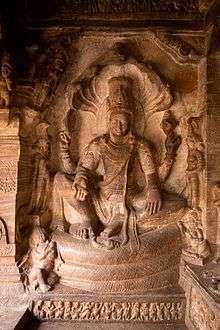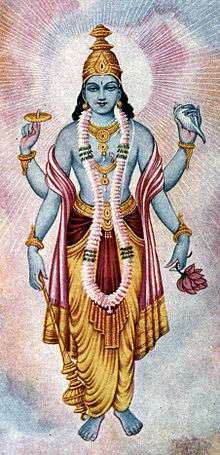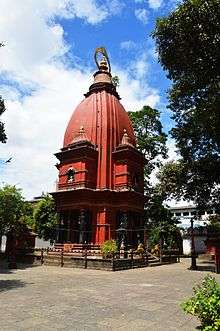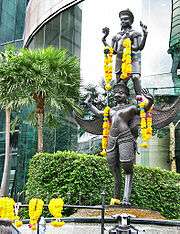Narayana
| Narayana (Hari) | |
|---|---|
 A depiction of Lord Narayana at Badami cave temples | |
| Affiliation | Deva, Trimurti |
| Abode | Vaikuntha |
| Mantra | ॐ नमो नारायणाय |
| Weapon | Chakra, Gada, Padma, Sankh |
| Mount | Garuda |
| Texts | Vedas |
| Consort | Sri |
| Part of a series on |
| Vaishnavism |
|---|
 |
|
Important deities |
|
Sampradayas |
|
|
Narayana (Sanskrit: नारायण, IAST: Nārāyaṇa), another name for Vishnu, is the supreme absolute being in Hinduism and is considered as the supreme deity in Vaishnavism. The Bhagavata Purana and Veda declares Narayana as the Para Brahman (Supreme Lord) who creates unlimited universes and enters each one of them as Lord of the Universe.[1]
Narayana engages in the creation of 14 worlds within the universe as Brahma when he deliberately accepts rajas guna according to Brahmanism. Narayana himself sustains, maintains and preserves the universe as Vishnu by accepting sattva guna. In Shaivism, Narayana annihilates the universe at the end of maha-kalpa as Shiva or Rudra when he accepts tamas guna.[2][3][4] According to the Bhagavata Purana, Narayana Sukta, Purush Sukta and Sri Sukta from Vedas, Lord Narayana is the supreme controller and is supreme among deities, the ultimate soul. He is also called as Surya Narayana, one who shines like the brilliant sun. [5][6] He is said to pervade whatever is seen or heard in this universe from inside and outside alike.[7] He is also mainly associated with the cosmic waters of creation.
According to Madhvacharya, Narayana is one of the five vyuhas of Vishnu, which are cosmic emanations of God in contrast to his incarnate avatars.[8]
According to Jain Cosmology, there are 9 Narayana that existed during current half time cycle. In every half time cycle, there are 9 sets of Balabhadras (gentle heroes), Narayanas/ Vasudevas (violent heroes) and Prati-Narayana/ Prativāsudevas (anti-heroes). Narayanas are part of the group of 63 Salakapurusa "illustrious or worthy persons" who appear during each half-time cycle.
Description

In the Vedas and Puranas, Lord Narayana is described as having the divine blue colour of water-filled clouds, four-armed, holding a padma (lotus flower), Kaumodaki (mace), Panchajanya shankha (conch) and the Sudarshana Chakra (discus).
Lord Narayana is also often identified as Sharangapani, Vishnu, Hari, Purushottama or Purusha and Jagannath in the Hindu sacred texts such as the Bhagavad Gita, the Vedas and the Puranas[9]. Narayana is also venerated as Mukunda[10] (giver of Moksha, liberation from cycle of births and deaths in the material world). In the Mahabharata, Krishna is often referred to as Narayana and Arjuna as Nara.[11] The epic identifies them both in plural 'Krishnas', or as part incarnations of the earlier incarnations of Vishnu, recalling their mystical identity as Nara-Narayana.[12]
Narayana is also described in the Bhagavad Gita as having a universal form (Vishvarupa) which is beyond the ordinary limits of human perception or imagination.[13]
Narayana's eternal and supreme abode beyond the material universe is Vaikuntha which is a realm of bliss and happiness called Paramapadha, which means final or highest place for liberated souls, where they enjoy bliss and happiness for eternity in the company of supreme lord. Vaikuntha is situated beyond the material universe and hence, cannot be perceived or measured by material science or logic.[14] Sometimes, Ksheera Sagara where Narayana or Vishnu rests on Ananta Shesha is also perceived as Vaikuntha within the material universe.
According to Jain texts on Salakapurusa, Narayana are generally of dark complexion and wear yellow garments. There are seven weapons and symbols of Narayana, namely: conch, discus (sudarshana chakra), club, bow, sword, jewel (kaustubha mani) and a garland of flowers (vanamala). Balabhadra and Narayana are mighty half brothers, who appear nine times in each half of the time cycles of the Jain cosmology and jointly rule half the earth as half-chakravarti. Ultimately Prati-naryana is killed by Narayana for his unrighteousness and immorality. Narayana are extremely powerful and are as powerful as 2 Balabhadras. Chakravartins are as powerful as 2 Narayanas. Hence Narayanas become half-chakravartins. Tirthankaras are much more powerful than Chakravartins. In Jain Mahabharta, there is a friendly duel between cousin brothers Neminatha (Tirthankara) and Krishna (Naryana) in which Neminath defeats Krishna without any effort at all. There is also a story of Neminath lifting Conch of Krishna and blowing it without any effort. In Jain Mahabharat, the main fight between Krishna and Jarasandha is described, who is killed by Krishna.
Ancient Texts
Lord Narayana is hailed in each and every part of Vedas like, Shatarudriyam, Purusha Suktam, Narayana Suktam, Hiranyagarbha Suktam, Vishnu Suktam, Rudra Suktam.
Lord Narayana is also hailed in the Upanishads like, Narayana Upanishad, Isopanishad, Chandogya Upanishad, Brihadaranyaka Upanishad, Mundaka Upanishad, Mandukya Upanishad, Katha Upanishad, Kenopanishad, Prasna Upanishad, Svetasvatara Upanishad, Maha Narayana Upanishad, Narasimha Tapani Upanishad.[15]
Etymology
There are multiple variations of Lord Narayana's name.
The word 'Narayana' means "The one who rests on waters of creation". The Manusmriti states,
- The waters are called "narah", for the waters are, indeed, produced by Nara-Narayana (the first Being); as they were his first residence "ayana", he is called Narayana.[16]
Narayana also means,
- "The Supreme Being who is the foundation of all men".[17]
Another interpretation sees,
- Nara means "human" and Ayana as "direction/goal". Some view Narayana as meaning "son of man." Hence, Narayana refers to the "direction of a human" (towards moksha).
Nara means "Human" and Ayana also means "Shelter" so Narayana means, shelter of all human beings. The Narayana Upanishad reads:
- Om Namo Narayanayeti mantra upasaka Vaikuntha bhuvanam gamishyati,[18]
In Sanskrit, The word 'Nara' can also refer to a man, male or a person[19]. Narayana is spoken of in the scriptures as being parabrahman, paramatma parameshwar parashakti and parajyothi which are all ways of saying "absolute" or "supreme".
In the Vedas, it is written,
- "Narayana parabrahman tatvam Narayana paraha"
which points to how Narayana is essentially the supreme force and/or essence of all.[20]
Gallery
 Narayan Temple on Narayanhiti palace premises, Kathmandu, Nepal
Narayan Temple on Narayanhiti palace premises, Kathmandu, Nepal Oldest Sridhar Narayan statue at Naksaal, Kathmandu
Oldest Sridhar Narayan statue at Naksaal, Kathmandu The bow of Royal Barge Narai Song Suban HM Rama IX of Thailand, it carved a image of Narayana ride a Garuda
The bow of Royal Barge Narai Song Suban HM Rama IX of Thailand, it carved a image of Narayana ride a Garuda.jpg) Idol of Narayana around 14/15th century, found at the Devasathan, inner Bangkok, Thailand
Idol of Narayana around 14/15th century, found at the Devasathan, inner Bangkok, Thailand Idol of Narayana ride a Garuda in front of InterContinental Bangkok, Phloen Chit Road, it is one of the most respected Hindu shrines in the Ratchaprasong neighbourhood alike Erawan Shrine
Idol of Narayana ride a Garuda in front of InterContinental Bangkok, Phloen Chit Road, it is one of the most respected Hindu shrines in the Ratchaprasong neighbourhood alike Erawan Shrine Drawing of sleeping Narayana on Sheshanaga while the four-headed Brahma springs from his navel
Drawing of sleeping Narayana on Sheshanaga while the four-headed Brahma springs from his navel- Statue of Narayana in Thai art style stands on Mount Mandara within Suvarnabhumi Airport, Samut Prakan, Thailand
.jpg) Lintel depicting Narayana sleeping upon the Sheshanaga in the middle of Milky Ocean, Bangkok National Museum
Lintel depicting Narayana sleeping upon the Sheshanaga in the middle of Milky Ocean, Bangkok National Museum
See also
References
- ↑ Bhagavata Purana Canto 2 Chapter 10 Verse 10
- ↑ Bhagavata Purana Canto 2 Chapter 5 Verse 16-18
- ↑ Bhagavata Purana Canto 11 Chapter 4 Verse 5
- ↑ Vishnu Purana 1.2.61-63
- ↑ Bhagavata Purana (12.12.56): "Narayanam Devam adevam isam - Lord Narayana, the Supreme controller and the ultimate Soul of all existence, beyond whom there is no other God.
- ↑ Bhagavata Purana (12.13.16): Just as the river Ganges is the greatest of all rivers, Lord Achyuta (Hari/Narayana) the supreme among deities (devas) and Lord Shambhu (Shiva) the greatest of Vaishnavas, so Bhagavata Purana is the greatest of all Puranas.
- ↑ http://sanskritdocuments.org/doc_vishhnu/narayana-sukta.html
- ↑ Bryant, Edwin F., Krishna: a Sourcebook. p.359 "Madhvacharya separates Vishnu’s manifestations into two groups: Vishnu’s vyuhas (emanations) and His avataras (incarnations). The vyuhas have their basis in the Pancharatra agamas, a sectarian text that was accepted as authoritative by both the Vishishtadvaita and Madhva schools of Vedanta. They are mechanisms by which the universe is ordered, was created, and evolves. According to Madhvacharya, Vishnu has either four or five vyuhas, named Narayana, Vasudeva, Sankarshana, Pradyumna and Aniruddha, which evolve one after the other in the development of the universe. The status of the fifth vyuha, Narayana, is not clear, and in some passages, he is not even mentioned."
- ↑ Bhagavad Gita (15.18): Because I am transcendental, beyond the fallible and the infallible, and because I am the greatest, I am celebrated both in the world and in the Vedas as that Supreme Person (Purushottama)
- ↑ Name No. 515 in Vishnu Sahasranama
- ↑ Vaisnavism Saivism and Minor Religious Systems, Ramkrishna Gopal Bhandarkar. Published by Asian Educational Services, p.46.
- ↑ Hiltebeitel, Alf (1990). The ritual of battle: Krishna in the Mahābhārata. Albany, N.Y: State University of New York Press. ISBN 0-7914-0249-5. p61
- ↑ Prabhupada, AC Bhaktivedanta. "Bhagavad-gita As It Is Chapter 11 Verse 3". vedabase.net. Archived from the original on 15 May 2008. Retrieved 10 May 2008. "see the cosmic manifestation"
- ↑ "Archived copy". Archived from the original on 15 May 2007. Retrieved 21 May 2007.
- ↑ "Narayanastra – Defending Vaishnavism as the supreme Vedic position". narayanastra.blogspot.in. Retrieved 2015-10-21.
- ↑ Manu Smruti 1:10 " The Law Code of Manu", Published by Oxford University Press, ISBN 0-19-280271-2, page 11, also, The Laws of Manu in the 21st Century by Pt. Sri Rama Ramanuja Acharya, page 6
- ↑ Harivansh, Adhyay 88 shlock 44, also, Manu Smruti 1:10 " The Law Code of Manu", Published by Oxford University Press, ISBN 0-19-280271-2, page 11
- ↑ http://www.sathyasaiottawa.org/pdf/Vedam/Narayana_Upanishad.pdf
- ↑ http://spokensanskrit.de/index.php?tinput=nara&script=&direction=SE&link=yes
- ↑ "॥ नारायणसूक्तम् सार्थ ॥ - .. Narayana Sukta .. - Sanskrit Documents". sanskritdocuments.org. Retrieved 2015-10-21.
External links
- Name of Narayana even at the time of death can save a great sinner, Ajamila.
- http://www.srivaishnavan.com/ans_secrets.html (See Answer #14.)
- http://www.ayurvedacollege.com/articles/drhalpern/om_namo_narayanaya Om Namo Narayana and Ayurveda
| Wikimedia Commons has media related to Narayana. |